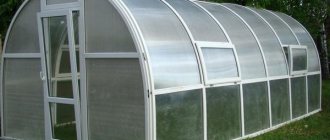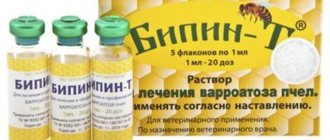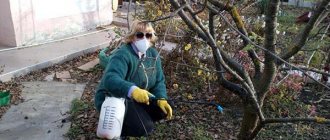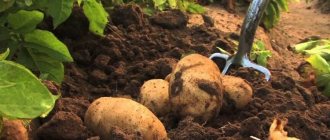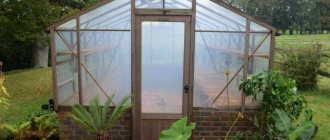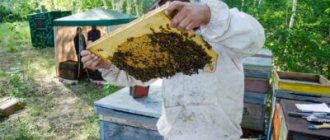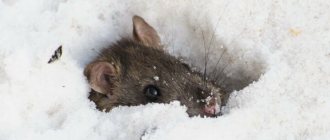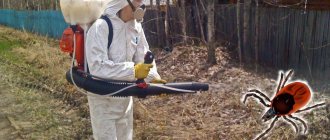Probably, on every plot of a private house or dacha there is a greenhouse or greenhouse. And in order for the cultivation of vegetable crops to bring maximum results, without unexpected difficulties in the form of outbreaks of diseases and pest invasions, you need to take care of your greenhouse. Therefore, after harvesting, it is very important to prepare the greenhouse (polycarbonate, film, glass) for winter and the next season.
By the way! The optimal timing for such autumn events is after harvest and before frost.
Why is autumn treatment of the greenhouse necessary?
It would seem, why do you actually need to treat the greenhouse in the fall after harvesting? Why can't we leave everything as it is? Under no circumstances should you let the situation take its course! And there is a very good reason for this.
The fact is that this structure is a closed system; various pests, pathogens, pathogenic microflora, residues of fertilizers, fungicides, and insecticides accumulate in it. At the same time, they can accumulate not only in the soil, but also on the walls and on plant debris.
If they are not destroyed by pathogens and pests, they will quietly overwinter. And with the onset of warmth in the spring, they will begin to actively reproduce, and then terrorize young seedlings and vegetable crops, which will reduce the quality and quantity of the harvest or completely deprive you of the desired fruits. Low soil fertility will lead to a poor harvest.
Due to dirt on the roof and walls, the greenhouse becomes darker, and poor lighting will negatively affect the plants and yield. In addition, it is easier to remove ice from a clean surface if necessary.
Key stages of processing a greenhouse in the fall and preparing it for winter:
- Elimination of all plant residues in the room.
- Washing and disinfection from the outside and inside.
- Soil preparation: digging, treatment and disinfection against diseases and pests, sowing green manure.
Cleaning up plant residues in a greenhouse
Plant debris (leaves, tops, rhizomes) and mulch may contain pathogens of dangerous diseases. The first step in cleaning a greenhouse is to remove absolutely all plant debris from it after harvesting . These include any parts of plants (tomatoes, cucumbers, cabbage, eggplants, bell peppers, etc.) that were grown in it, weeds. In this case, they must be removed along with the rhizome .
In addition, you need to remove all the mulch!
Advice! Parts of plants and mulch should not be taken to the compost heap or to another part of the garden. It's better to burn them right away!
Treatment of the greenhouse structure: washing and disinfection
Throughout the season, the greenhouse becomes dirty both outside and inside. Dirt, cobwebs, and moss stick to its walls, leaves fall on the roof, dust accumulates, and stains from precipitation accumulate. The structure may be contaminated with pathogens of fungal diseases, infections, and pathogens. For this reason, it is very important to wash and disinfect the structure in the fall to prepare it for the next season and winter.
Important! In the fall, any damage to the metal frame must be treated: brushed, primed with an anti-corrosion agent and painted. If this is not done, the structure will continue to corrode and collapse.
Greenhouse flushing
The primary task in the fall is to wash the greenhouse structure . It is necessary to prepare tools: rags, a broom, a window mop, a hose, detergents (more on them a little later).
First, you can walk with a broom and brush away obvious dirt and cobwebs.
The outside of the greenhouse can be washed with plain water , and it is optimal to do this with water pressure from a hose or simply rinse with a mop. The roof and outer walls need to be cleaned thoroughly, washing away all dirt, dust and leaves.
Note! Any twines or ropes to which you tied the plants must be removed from the room (preferably burned). However, if you feel sorry for getting rid of them, you can soak them in a dark solution of potassium permanganate for 40-60 minutes.
What is the best way to wash the inside of a greenhouse? There are several options and recipes for detergents:
- Laundry soap (one bar) per bucket of water.
- Baking soda (2 tablespoons) in a bucket of water.
- Mustard powder (2 tbsp) in a bucket of water.
- Tar or laundry soap (100 grams), 70% acetic acid (1 teaspoon), a bucket of water.
- If there are mosses and lichens on the structure, then a five percent solution of copper sulfate can be used for these areas.
It is necessary to clean the walls and roof of the greenhouse from the inside according to the following scheme:
- It is necessary to apply a cleaning solution to the surfaces. It is best to use sponges for walls and a mop for ceilings.
- Leave the solution for 5-10 minutes (in this case, you need to leave the structure and wait outside).
- Then you need to thoroughly rinse the surface with plain water.
Note! According to the same scheme, you need to process the racks, the equipment that is used in it, the supports (regardless of what material they are made of - wood, metal).
Disinfection (disinfection) of the greenhouse
It is necessary to disinfect a greenhouse in the fall with potent drugs only if it has been damaged by diseases and pests.
If your vegetable crops grew safely and no signs of diseases or pests were identified, then you can simply limit yourself to simple surface cleaning, which was described above.
So, the structure can be processed using a sulfur bomb or using chemicals.
Fumigation with a sulfur bomb
Fumigation with a sulfur bomb is a very effective way to disinfect the internal surface of a greenhouse and soil. Using this disinfection method, pathogens of fungal and bacterial infections, mold, and pests can be eliminated. Fumigation should be carried out at an air temperature of at least +10 degrees.
Important! Before using the sulfur bomb, you must carefully study the instructions and follow all the rules described in it!
Fumigation with a sulfur bomb to disinfect a greenhouse is carried out according to the following rules:
- Shortly before the event, you need to wash the inside of the structure. Then dig up the soil with the bayonet of a shovel so that the smoke penetrates deeply into the soil and more thoroughly eliminates pathogens and pests in it.
- The sulfur block must be placed on any hard surface (brick, tile). Then you need to set the checker on fire using paper.
Important! The smoke (sulfur dioxide) released when burning a bomb is very dangerous for humans ! Immediately after setting the checker on fire, you need to leave the greenhouse and enter it no earlier than 3-4 days later!
- 4-5 days after using the smoke bomb, you need to thoroughly ventilate the greenhouse, and then wash the surfaces of the structure from the inside again and remove the soot.
- After fumigation, it is imperative to restore soil fertility, because beneficial bacteria and fungi die along with pathogenic microorganisms. For these purposes, you can use, for example, the drug “Fitosporin-M”, “Baikal EM1”, “Azotofit”.
In what cases is it not recommended to use a sulfur bomb?
- In greenhouses with a frame made of unpainted (non-galvanized) metal profiles. A chemical reaction will occur leading to corrosion. However, if the design contains small metal parts, they can be protected by lubricating them with grease.
- Also, some manufacturers do not recommend fumigation with a saber in polycarbonate greenhouses , because it will cause the surface of the material to darken (the lighting will deteriorate, which is very bad for plant photosynthesis). However, this is only possible with frequent processing. And as experience shows, many summer residents do not notice any negative changes after the procedure.
Use of chemicals
Important! When using chemicals, you must follow the safety rules:
- It is necessary to use personal protective equipment: respirator, safety glasses, rubber gloves, aprons.
- You cannot stay inside the greenhouse during processing for more than 5-10 minutes.
- After the procedure, you need to thoroughly wash your hands, face, and mouth.
- It is necessary to carefully study the instructions for use of the drug and follow safety precautions.
Instead of using a sulfur bomb, you can treat the greenhouse in the fall using chemicals:
- Copper sulfate. If your plants have previously been exposed to diseases, then you need to dilute 150 grams per 10 liters of water. If there were no signs of disease, then for prevention purposes you can dilute 80 grams per 10 liters of water.
Important! Copper sulfate cannot be used annually, as it accumulates in the soil and negatively affects plants! In general, copper-containing preparations should be used very carefully!
- Bleaching powder. To prepare the solution, you need to dilute 400 grams of the substance in 10 liters of water, leave for several hours, and then strain.
Important! After treating the greenhouse, you need to immediately close it completely (both the door and the windows) and leave it for 2-3 days, and then ventilate it well.
The use of chemical fungicides has a negative effect on beneficial soil microorganisms, so after treatment it is necessary to shed the soil “Fitosporin-M”, “Baikal EM1”, “Azotofit” . However, such products are effective at temperatures above +10 degrees.
Autumn treatment of greenhouses against pests
Treating a greenhouse against pests in the fall is an extremely important stage in preparing the structure for wintering and the new summer cottage season in the fall. If you do not take pest control measures for the winter, pests can successfully overwinter indoors and encroach on vegetable seedlings in the spring.
To achieve maximum effectiveness, it is necessary to use the most suitable insecticide preparations for a particular pest:
- Nematode - for example, the drugs Carbation, Chloropicrin, Nemagon are suitable. Before using the insecticide, you should soak the soil with boiling water for an hour.
- Aphids - Kinmiks, Iskra, Karate, Bitoxibacillin, Fitoverm, sulfur bomb.
- Whitefly - Fitoverm, Confidor, Aktellik, Aktara.
- Putin tick - Fitoverm, Aktofit, Vertimek, sulfur bomb.
- cricket, wireworm, cockchafer larvae - Medvetoks, Zemlin, Rubit Rofatoks, sulfur checker. In this case, it is recommended to first spill the soil with boiling water, and then use the drug.
In this case, you need to spray not only the soil, but also the structure itself.
Signs of presence and harm caused
Aphids are sucking pests. It feeds on the juice of leaves and shoots. During its life, it produces honeydew - substances saturated with sugars.
It is quite easy to understand that cucumbers or tomatoes are affected by aphids - small insects will swarm under each young leaf.
In addition, in the greenhouse there are:
- deformed shoots;
- curled leaves;
- sticky marks on green fabrics.
Indirect signs will be:
- the appearance of ants;
- growth slowdown;
- absence or shedding of the ovary.
The weakening of tomatoes and cucumbers in a greenhouse as a result of aphids has many consequences:
- Slowing growth and shedding of the ovary significantly affect the future harvest of tomatoes or cucumbers in the greenhouse.
- Weakened immunity makes them vulnerable to diseases. Aphids carry viruses, and fungi parasitize on sugary secretions. If you do not fight aphids, greenhouse crops will quickly die.
Preparing the soil for winter: treating against diseases, digging, replacing, sowing green manure
Treating the soil against pests is very important for properly preparing the greenhouse for winter. In addition, it is necessary to dig, replace the top soil layer (if necessary) and sow green manure.
Advice! It is optimal to do autumn soil preparation at the end of September, in the first half of October. It is very important to be in time before the first frost!
Digging the soil
To achieve maximum efficiency in soil disinfection, it is necessary to first dig up the area in the greenhouse.
You need to dig up the soil using the bayonet of a shovel . At the same time, after digging, there is no need to disassemble clods of earth and loosen them.
In addition to the fact that spraying the soil with fungicides will be the most effective, the soil will freeze better in winter, which will have a positive effect on the elimination of pathogens and pests.
Soil disinfection
The most important stage in preparing a greenhouse for winter and the new dacha season is preventative tillage of the soil against diseases in the fall. After all, it is easier to prevent them by spending a little time on prevention, rather than then spending energy on eliminating the disease, treating plants and saving the harvest.
Important! As noted above, when using chemicals, you must follow safety precautions: use personal protective equipment, do not stay in the room for more than 5-10 minutes, follow the instructions, and then thoroughly wash your hands, face, and mouth.
To disinfect soil to prevent diseases, you can use:
- Chemical fungicides , for example, preparations Hom, Oxychom, Quadris, Bravo, 1% copper sulfate (100 grams per 10 liters of water), Bordeaux mixture.
- Biological preparations , for example, Fitosporin-M, Baikal EM1, Trichodermin, Baktofit.
Advice! If the plants in your greenhouse area have not previously suffered from diseases, then it is better to use biological preparations, because they are safer, and also heal the soil and restore soil fertility.
At the same time, to achieve the greatest efficiency, it is recommended to re-cultivate the soil after 2 weeks.
If the plants in your greenhouse have been exposed to diseases, then the following preparations can be used for effective treatment in the fall:
- Against late blight, you can treat the soil with a solution, for example, Hom, Abiga-Pik, Consento, Revus, Fitosporin-M, 3% Bordeaux mixture.
- To combat powdery mildew, you can shed the soil with a solution of Topaz, Gamair, Quadris, Tiovit Jet, Fitosporin-M.
- Against brown spot (cladosporiosis), you can use Hom, Fitosporin-M, Pseudobacterin-2, Polyram, 3% Bordeaux mixture.
- against fusarium in the fall with Oxyx, Trichofit, Gamair, Energy, Previkur.
- For treatment against root rot, you can use the drugs Trichodermin, Baktofit, Gamair, Pseudobacterin-2, Planriz.
By the way! As already noted in this material, sulfur bomb perfectly disinfects the soil.
Important! If you use any chemical fungicides, then after them you must definitely restore the soil microflora, for example, using Fitosporin or Baikal EM1, Baktofit.
Replacing the top fertile layer
In the soil under greenhouse conditions, over time, fertilizers, remnants of fungicides, insecticides accumulate, and if disinfection is insufficient, pathogens accumulate. Therefore, once every 3-4 years it is recommended to replace the top fertile layer of soil in the greenhouse (the first 10-15 centimeters).
Replacing the soil improves the quality of the soil, minimizes the risk of developing diseases and breeding pests (however, it is not a complete guarantee of this!).
The old soil layer can be spread out on your site, but if you are sure that the soil is of poor quality, then it is better to take it somewhere outside your site.
In place of the old soil, you can bring regular soil from your site. But it is better to use a mixture to create a fertile soil layer: peat, humus or compost, sand (all ingredients in equal proportions). It is also advisable to add ash to the mixture (200 grams per square meter).
Note! If the procedure is not possible for you, then you can do without replacing the top layer of soil in the greenhouse and simply spread the above ingredients on the surface (or better yet, dig up the area with them).
Sowing green manure in a greenhouse
Green manure is very useful for any soil in your garden, including in a greenhouse. Sowing green manure will bring many benefits: they loosen the soil, improve its air exchange, saturate the soil with nitrogen and other useful substances, and promote soil disinfection. Therefore, it is highly recommended to carry out such preparation of the soil in the fall for winter and the next summer season.
It is optimal to sow green manure at the end of September or at the beginning of October. If you don’t have time to plant them at the right time, you can do winter sowing in November.
For a greenhouse, it is optimal to sow the following green manures:
- white mustard;
- Vika;
- rye;
- alfalfa;
- phacelia.
You can sow seeds simply by scattering them around the perimeter of the structure. Or you can make furrows and plant green manure in them, and then seal them with a rake.
After planting, you should water the soil (it is more effective to use not just water, but a solution of Fitosporin).
When sowing in early autumn, it is necessary to regularly water the soil for 15 days (preferably every day). Or mulch with compost or agrofibre to retain moisture.
At the end of autumn, it is necessary to check the condition of green manure. If they have grown enough, then you need to cut them at ground level and leave them on the site. If they have grown quite a bit, then you can leave everything as is for the winter.
Important! It is necessary to sow green manure in a greenhouse in the fall after disinfecting the structure and soil (i.e., after fumigation with a saber or spilling a solution of a chemical fungicide). If planted before such treatment, the green manure will die.
Application of organic fertilizers
If you have a greenhouse growing vegetable crops that love fertile soil, for example, tomatoes, cucumbers, eggplants, peppers, etc., then it is recommended to use fertilizers in the fall. It is advisable to fertilize the soil if you have not replaced the topsoil.
Organic fertilizers are suitable - compost, humus (1 bucket of organic matter per square meter of area). Afterwards you need to dig up.
How to fertilize the soil?
After harvesting the soil before the onset of winter, it is necessary to feed it so that it can recover for the next sowing season. The procedure is important especially when tomatoes were grown in a greenhouse. This crop is demanding on the soil, so it takes all the nutrients from it and it loses its fertility.
Nutrient supplements can be bought ready-made, but preparing them yourself is not difficult. For this you will need compost and wood ash. The next layer consists of sand and sawdust. For 1 m2 you need a bucket of manure and peat. Dig up.
Attention!
Using manure can contaminate the area with fungal infections and bacteria. Therefore, immediately after applying such fertilizer, the soil must be watered for disinfection with a solution of copper sulfate. Repeat the procedure in the spring.
In the fall, you need to fertilize the soil in a greenhouse not only with organic fertilizers - you can also add complex mineral fertilizers. In the case when the greenhouse is constantly covered and is not affected by precipitation, it is permissible to apply fertilizers containing potassium and phosphorus in early or mid-autumn. They gradually dissolve in moist soil without being washed out. Therefore, in the spring the plants will receive them in the required quantity.
On average, per 1 m2 you will need 40-60 g of superphosphate, 25-30 g of potassium salt or potassium sulfide.
General recommendations for preparing a greenhouse for winter and the new season
In general, everything is described above about how to treat a greenhouse in the fall and prepare it for winter, but I would like to note a few more features and rules for caring for the structure in the autumn-winter period:
- It is necessary to treat not only the greenhouse and the soil with fungicides, but also the tools that are used in it (secateurs, rake, shovel, hoe, saw, etc.). After all, if they are not disinfected, they can become a source of infection. After processing, you need to move them to a dry, closed room.
- If the reliability of the frame does not inspire confidence, then at the end of autumn you can strengthen the frame so that it does not collapse under the weight of snow. The easiest way is to place wooden or metal supports inside the structure.
- Also, if the structure does not seem reliable, then in case of heavy rainfall it is recommended to remove snow from the roof surface.
- In winter, the door to the greenhouse must be closed so that wind and bad weather do not damage the structure. However, if the manufacturer of the building recommends leaving the door open for the winter, then it is better to follow this advice (but again, if your region has very frosty winters and strong, cold winds, then it is better to open only the window and securely fix it).
- At the end of winter or early spring, it is recommended to throw snow into the greenhouse so that the soil is saturated with melt water. Bringing snow earlier is not recommended, because the ground covered with warm snow is more favorable for wintering pests. In addition, soil without snow freezes better, which is very good for preventing pests and diseases.
Autumn is a time of intensive preparation for winter and caring for the garden after harvest. We should not ignore greenhouse structures and greenhouses, because they help us get a good and tasty harvest of vegetables. Also, don’t put it off until spring; it’s much more efficient to do everything in the fall. Besides, there is so much to do in the spring, so you will spend your time and energy rationally.
Set of measures
Preparation of the greenhouse in the fall should take place at an air temperature of +10-15 ° C, in dry weather. Competent preventive maintenance of the structure and high-quality soil care in the greenhouse in the fall are carried out in several stages:
- cleaning;
- spring-cleaning;
- disinfection of surfaces;
- repair of the structure;
- cultivating the soil in a greenhouse in the fall: applying chemicals - fertilizers, drugs against pests and infections, fertilizing, improving the soil structure, digging or replacing the fertile layer;
- strengthening the structure;
- insulation, additional lighting, heating (if necessary).
The video shows a step-by-step process of how the autumn treatment of a polycarbonate greenhouse is carried out; the video recommends preparations for cleaning the structure.
